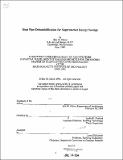Heat pipe dehumidification for supermarket energy savings
Author(s)
Oliver, Eric M. (Eric Michael)
DownloadFull printable version (20.81Mb)
Other Contributors
Massachusetts Institute of Technology. Dept. of Architecture.
Advisor
Leslie K. Norford.
Terms of use
Metadata
Show full item recordAbstract
This thesis examines the possibility of using a heat pipe installed in the air conditioning unit of a supermarket to increase the level of dehumidification of the inside air. This dehumidification is expected to reduce the energy consumption of the refrigeration system due to an improved efficiency of the heat transfer at the display case. This increase in efficiency will be due to reduced frost buildup on the refrigeration coils. Chapter two includes a physical and psychometric analysis of the heat pipe, proving that for any system where direct evaporation dehumidification is used, at any given time when dehumidification is being performed, the addition of a heat pipe will increase the amount of moisture being removed by the cooling coil. For this thesis, a heat pipe was installed in a supermarket in Worcester, Massachusetts. Over a period of the summer from the beginning of June to the end of October, various air temperatures and relative humidities, refrigeration line temperatures, pressures, and mass flows, and compressor power consumption were monitored for fifteen minute periods. The monitoring period included two months before the installation and three months after the installation to determine changes in the air system and refrigeration system due to the presence of the heat pipe. Chapters two through five describe the equipment, site and strategy used in the analysis. Chapter six describes the results of the monitoring, and Chapters seven and eight give the results of the air system and refrigeration system models. The systems were modelled using monitored data and engineering equations to predict humidity levels and power consumption based on ambient conditions. The analysis was unique in that a heat pipe application had never been previously studied in a Northeast location, since the mild summers made dehumidification less of an issue than in Southern states. This study was also considerably more in depth than previous studies (summarized in Chapter 2), for which savings estimates do not account for large potential errors. This study concluded that potential savings estimates (0-8% reduction in supply air humidity, -1 % reduction in refrigeration power) were within statistical error (9% for specific humidity, 4% for refrigeration power), and therefore inconclusive. Further studies with superior equipment and modelling strategies are needed to substantiate heat pipe dehumidification.
Description
Thesis (M.S.)--Massachusetts Institute of Technology, Dept. of Architecture, 1994. Includes bibliographical references (leaves 178-179).
Date issued
1994Department
Massachusetts Institute of Technology. Department of ArchitecturePublisher
Massachusetts Institute of Technology
Keywords
Architecture.